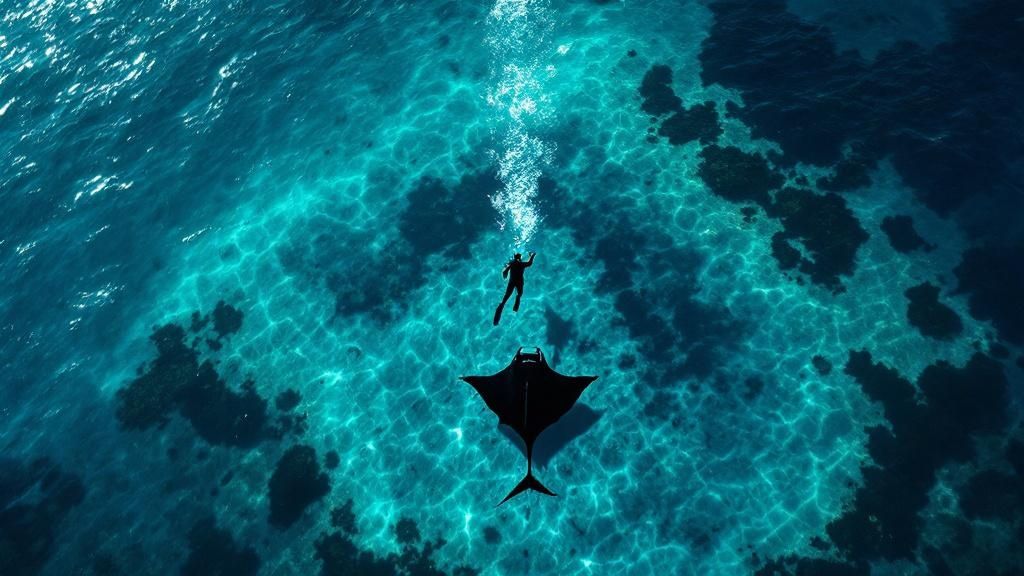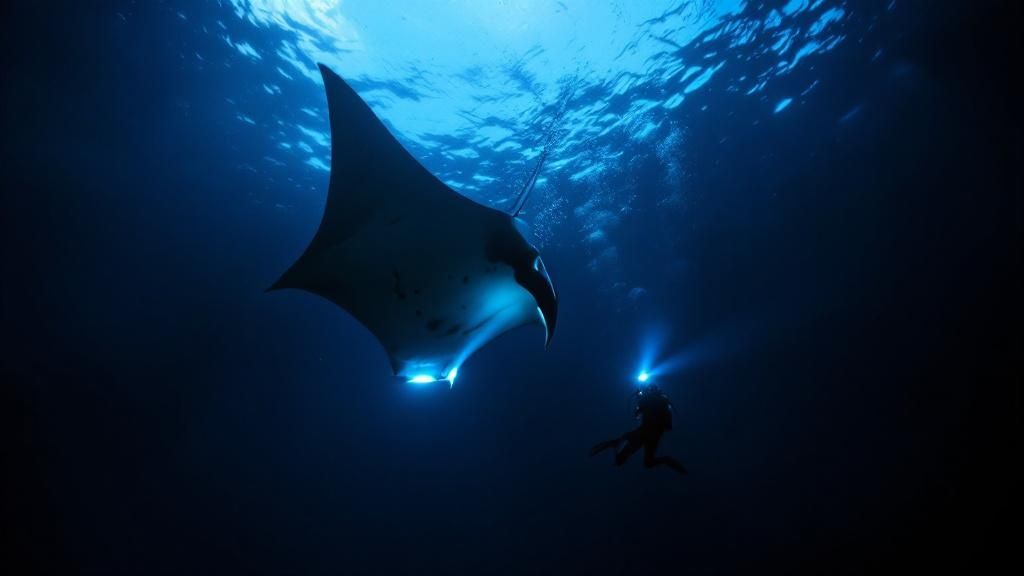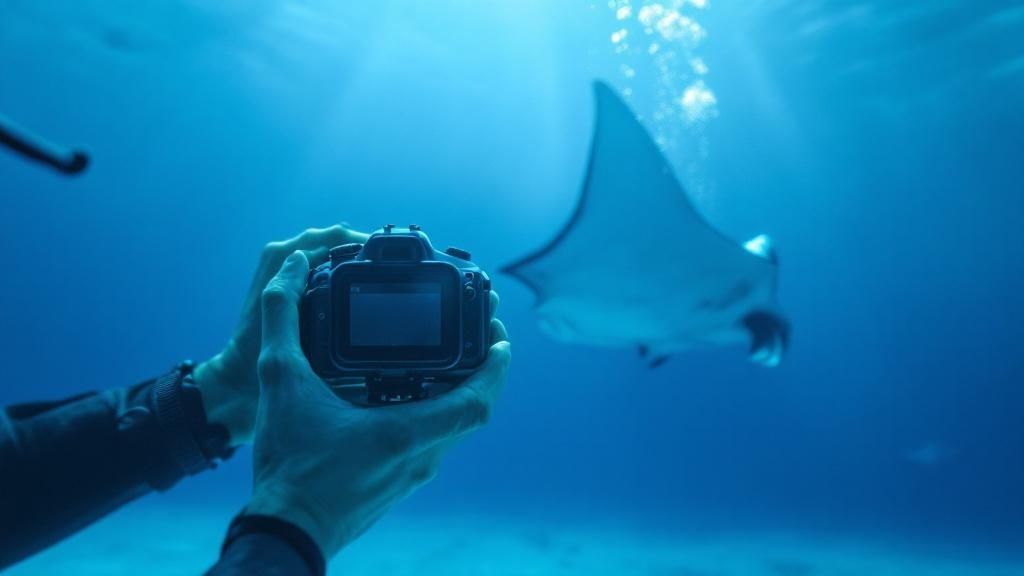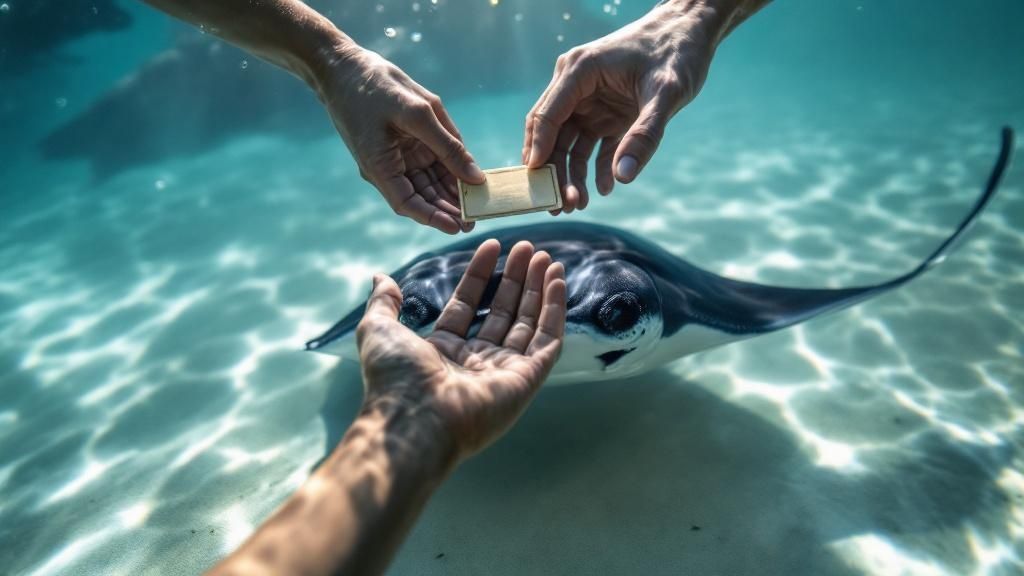Picture this: you’re floating weightlessly in the warm, dark Pacific Ocean off the coast of Kona. Suddenly, a giant, graceful shadow emerges from the deep, soaring like an underwater bird. This is the manta ray night dive, an experience consistently hailed as one of the best night dives in the world. It's a genuine, up-close encounter with gentle giants that feels almost otherworldly.
What Makes the Kona Manta Ray Dive So Special?
The Kona Coast of Hawaii’s Big Island isn't just another pretty spot to go diving. It's a globally famous sanctuary for manta rays, and that’s no accident. The unique underwater landscape, carved out by ancient lava flows, has created the perfect conditions for these magnificent creatures to gather and feed all year long. This is the secret behind why the manta ray dive in Kona is so reliably incredible.
Think of it as a five-star restaurant designed specifically for mantas. The underwater terrain naturally funnels their favorite food, plankton, into a few key spots. But the real show begins after the sun goes down. Dive operators set up what we call the "campfire"—powerful, stationary lights placed on the ocean floor. This light attracts a massive cloud of plankton, essentially ringing a dinner bell that the local manta population has learned to recognize.
A Guaranteed Natural Spectacle
This brilliant setup turns an already cool night dive into a spectacular performance. As a diver, you get settled on the sandy bottom, point your own dive light up, and add to the glowing buffet. Then, out of the darkness, they appear. The mantas glide in, swooping and barrel-rolling through the light beams as they filter mouthfuls of plankton, sometimes just inches from your mask.
This incredibly reliable method is precisely why Kona has become the world's epicenter for manta ray encounters. The experience draws around 80,000 visitors every year, and it's common to see an average of 8 to 12 manta rays on any given night. The sheer consistency of these sightings is what makes this dive so different from almost any other wildlife interaction you can have. You can dive deeper into the impressive statistics behind Kona's manta population on konahonudivers.com.
Before you book, it helps to have a quick snapshot of what to expect.
Kona Manta Ray Dive Quick Overview
Here's a table summarizing the key details you'll want to know for planning your manta ray adventure.
| Aspect | What to Expect |
|---|---|
| Location | The Kona Coast on the Big Island of Hawaii |
| Best Time to Go | Year-round, thanks to a resident manta population |
| Experience Type | Both snorkeling and scuba diving options are available |
| Average Sightings | Typically 8 to 12 manta rays per tour |
| Water Temperature | Varies from 74-80°F (23-27°C) depending on the season |
| What You Do | Hold onto a light source or settle on the seafloor to attract plankton |
| Key Attraction | Watching mantas feed up close as they perform graceful "barrel rolls" |
This unique combination of factors ensures you're not just hoping for a chance encounter; you're stepping into a well-established, natural feeding event.
The experience feels less like observing wildlife from afar and more like being invited to a secret, underwater banquet. It’s this close, personal, and predictable nature of the encounter that creates a memory that truly lasts a lifetime.
The result is a breathtaking underwater ballet. You aren't just a distant observer; you are part of the scenery, a silent guest with a front-row seat to one of nature's greatest shows. It’s this immersive and intimate experience that makes the manta ray dive Kona a top bucket-list item for adventurers across the globe.
Choosing Your Ideal Manta Dive Site

When you start planning your manta ray dive in Kona, you'll quickly realize there are two main, world-famous spots. The question isn't about which one is "better," but which one is the right fit for you. It’s a bit like choosing between two legendary concert venues—both put on an incredible show, but the vibe, the crowd, and the journey to get there are completely different.
These two sites are affectionately known as Manta Village and Manta Heaven. Your choice here will define the entire experience, from how long you're on the boat to the kind of encounter you'll have with the mantas. Getting to know their personalities is the first step in booking an adventure you'll never forget.
Manta Village: The Established Classic
Right offshore from the Sheraton Keauhou Bay Resort, you'll find Manta Village. This is the original, the classic, the place where Kona's manta ray dives all began. Because it’s tucked into a protected bay, the water is almost always calmer and shallower, with the sandy bottom sitting at about 25 to 35 feet deep.
This makes it a fantastic option for first-time night divers, snorkelers, or anyone who gets a little queasy on boats. The ride from Keauhou Harbor is super short, sometimes just a few minutes. While the encounters are incredibly reliable, you might see a slightly smaller number of mantas here. But don't let that deter you—its consistency is legendary, with some operators reporting a sighting success rate as high as 96%.
I often tell people Manta Village feels like an intimate theater. The setting is cozy, getting there is easy, and the performance is consistently breathtaking. It’s a comfortable and reliable choice for a magical night.
Manta Heaven: The Grand Spectacle
Head a bit further north, up near the Kona International Airport, and you'll find Manta Heaven (also called Garden Eel Cove). This spot is a little deeper and more exposed to the open ocean, which means conditions can be more variable. The payoff? The potential for a truly epic spectacle. On a good night, you could see a dozen or more mantas swirling in a massive, beautiful vortex.
Because it's farther from Kona's main harbors, the boat ride is longer. This site is a great match for more experienced divers who don't mind potentially choppier seas and are chasing that chance to see a truly massive manta ballet. The success rate here is also fantastic, consistently hovering around 90%.
Comparing the Manta Dive Sites
To make the decision easier, here’s a quick side-by-side look at the two premier locations for your manta ray dive in Kona.
| Feature | Manta Village (Keauhou) | Manta Heaven (Airport) |
|---|---|---|
| Location | South of Kailua-Kona | North of Kailua-Kona |
| Water Depth | Shallower (25-35 ft) | Deeper (30-40 ft) |
| Conditions | Generally calmer, more protected | Can be choppier, more exposed |
| Best For | Snorkelers, beginners, those prone to seasickness | Experienced divers, thrill-seekers |
| Travel Time | Short boat ride from Keauhou Bay | Longer boat ride from Honokohau Harbor |
| Manta Sightings | Highly reliable, often smaller groups | Very reliable, often larger groups |
Ultimately, you can't go wrong. Both sites offer a front-row seat to one of the most incredible wildlife encounters on the planet. Your decision really boils down to your personal style: do you want the calm, dependable intimacy of Manta Village, or are you willing to trade a longer boat ride for the chance at a grand, dramatic spectacle at Manta Heaven?
How to Prepare for Your Manta Ray Night Dive Adventure

A little bit of prep work can make a world of difference between a good night and a truly magical one. When you show up at the dock ready to go, you can leave the small worries behind and soak in every moment of the incredible experience ahead.
Think about your prep in two simple categories: what to bring, and how to get your body and mind ready. The good news is that most quality tour operators provide all the essential gear you'll need in the water—wetsuits, masks, fins, and the powerful lights that draw in the plankton. This means you don’t have to lug your own equipment, unless you have a favorite mask or a personal set you’re more comfortable with.
What to Pack in Your Dry Bag
Your main goal here is to plan for comfort, especially for the time you're not in the water. Even after a warm Hawaiian day, zipping back to the harbor on a boat can get surprisingly brisk once you're wet.
Here’s a quick checklist of things you’ll be glad you brought:
- A warm towel and a change of clothes. Seriously, a dry hoodie or fleece jacket feels amazing on the ride back.
- Reef-safe sunscreen. If you're on a sunset trip, be sure to apply it before you head out. That late afternoon sun is still plenty strong.
- An underwater camera. Got a GoPro? Make sure it's fully charged with a clear memory card. You won't want to miss this.
- A reusable water bottle. Staying hydrated is always a good idea and can even help keep seasickness at bay.
Getting Physically and Mentally Ready
Having the right gear is one thing, but feeling your best is just as important. For many people, floating in the open ocean after dark is a brand new sensation, and it's totally normal to feel a few butterflies. The trick is to turn those jitters into pure, unadulterated excitement. To get a better sense of what you're signing up for, you can learn all about what a manta ray night dive is in our detailed guide.
Seasickness is a common worry, and it’s a surefire way to spoil the fun. The best approach is to get ahead of it. If you even think you might get motion sick, take an over-the-counter remedy before you board the boat.
A light meal and plenty of water beforehand can also help settle your stomach. Once you're on the boat, find a spot where you can look out at the horizon and take some deep, steadying breaths. Your guides are experts at walking everyone through the process, and their calm confidence is infectious. Before you know it, any nervousness will have melted away, replaced by anticipation for the main event.
What to Expect During Your Manta Ray Encounter
The moment you step on the boat, the excitement is real. It’s not just about getting on the water; it's the start of the adventure. Your guides kick things off with a thorough safety briefing, but they're more than just safety officers—they're storytellers who are genuinely passionate about these animals. They’ll cover everything you need to know, from how to get in the water to the most important rule: look, but don’t touch.
As the boat heads out, you’ll get a front-row seat to one of Kona’s legendary sunsets. This isn't just a commute to the dive site; it’s part of the experience. The crew will start sharing incredible facts about the local manta population, transforming any butterflies you might have into pure anticipation for what's coming next.
Entering the Underwater Theater
Once we're anchored, the crew helps everyone get suited up and into the dark, surprisingly warm ocean. This is where the real magic begins. If you're snorkeling, you'll hold onto a large, specially-made floatation board. This board is equipped with powerful lights that shine straight down, creating a glowing column in the water that immediately starts to attract plankton.
For scuba divers, it's a short trip down to the sandy bottom, usually somewhere between 25 to 40 feet. You’ll settle into a designated spot and point your dive light up, adding your beam to the collective glow. Together, all the lights create what we call the underwater "campfire."
Think of it like being in a pitch-black theater where every person in the audience turns on a flashlight and points it at the stage. That combined light creates a massive, irresistible beacon for plankton, which is basically ringing the dinner bell for the manta rays.
The Manta Ballet Begins
At first, all you see is a shimmering cloud of tiny plankton. Then, out of the deep blue, a massive shadow glides gracefully into the light. Soon, another joins, and then another. The mantas start their mesmerizing ballet, swooping and barrel-rolling through the light beams with an elegance that defies their size, their huge mouths open to scoop up their meal.
They'll soar just inches from your face, so close you can feel the gentle push of water from their massive wings. It's a completely silent, awe-inspiring spectacle. Our guides are right there in the water with you, making sure everyone stays in a safe viewing position so the mantas have a clear path to feed. To get a full picture of this incredible trip, you can read more about the Kona Honu Divers manta ray night dive in Hawaii.
This up-close performance usually lasts for about 30 to 45 minutes—a stretch of time where you’re simply a guest at one of the greatest shows on Earth.
Keeping the Manta Ballet Safe and Wild

Watching the manta rays perform their nightly ballet is a privilege we all share a responsibility to protect. The entire encounter is built on a simple yet powerful idea: passive interaction. It’s the key to making sure these gentle giants stay safe, wild, and comfortable in our presence.
The absolute golden rule of every manta ray dive in Kona is simple: look, but never, ever touch. This isn't just a friendly suggestion; it's a critical conservation rule. Manta rays have a thin, protective mucus layer covering their skin, which is their first line of defense against ocean bacteria and parasites.
When you touch a manta, you can inadvertently wipe off this crucial slime coat. Think of it like stripping the waterproof layer off a jacket—suddenly, they're exposed and vulnerable to infection and disease.
The Rules of the "Dance Floor"
To keep both people and mantas safe, every operator follows a strict set of guidelines. These rules aren’t there to ruin your fun. In fact, they create a predictable, calm environment that allows the mantas to relax and feed naturally, giving you a much better show. It all comes down to where you are in the water.
- Divers on the Seafloor: If you're diving, you'll settle on the sandy bottom. This keeps the water column above you wide open, giving the mantas a clear "stage" to swoop and glide without having to dodge obstacles.
- Snorkelers at the Surface: As a snorkeler, you'll stay on the surface, usually holding onto a custom-built light raft. This is crucial because it stops fins from kicking down into the mantas' path, which could easily startle them or lead to an accidental bump.
- Let Your Light Shine: Your dive light is the bait. Divers point their beams straight up, and the snorkel rafts shine down, creating a "plankton campfire" in the middle of the water. This concentrates their food source and draws the mantas right in.
Following these guidelines is the single most important thing you can do to help. It's how we ensure Kona’s manta population continues to thrive, so this incredible experience is around for generations to come.
This whole system wasn't just made up; it’s the result of years of careful study. Between 2009 and 2014, intensive research and tracking of the Kona manta population gave us the blueprint for the sustainable model we use today. This work found the perfect balance between giving guests a jaw-dropping experience and putting manta conservation first.
By being a respectful observer, you're not just a tourist—you become an active part of this amazing conservation success story. You can discover more about the research shaping Kona's manta dives and see how science keeps this underwater spectacle alive and well.
How to Book the Best Manta Ray Tour in Kona
Picking the right company for your manta ray tour is what separates a good trip from an absolutely mind-blowing one. Dozens of boats head out every night in Kona, so it can feel a little overwhelming, but a few key things will help you find a truly great operator—one that puts safety and respect for the ocean first.
Your first step should always be checking out an operator’s safety record and what past guests have to say. You want a crew with seasoned, certified guides who know these specific waters like the back of their hand. I also look for a smaller guide-to-guest ratio. It’s a huge plus, meaning you get more personal attention and a much less crowded, more intimate experience with the mantas.
Look for Sustainable Practices
Next, dig into how the company approaches sustainability. While the old "Manta Ray Green List" program isn't around anymore, the best operators still live by its code. This means they are serious about protecting the mantas. They'll enforce a strict no-touching rule and carefully manage where everyone is in the water to give the rays plenty of room to do their thing.
When you choose a company that puts the mantas' well-being first, you're not just doing the right thing—you're setting yourself up for a better show. Mantas that feel safe and unbothered will hang around longer, giving you more time to witness that incredible feeding ballet.
Finally, make sure to book your tour well in advance. This is especially true if you’re visiting during the busy season, which generally runs from April through October. The top-rated tours can be sold out for weeks, so booking early locks in your spot. It also gives you a safety net to reschedule if bad weather forces a cancellation.
- Scuba vs. Snorkel: Think about what you want to see. Do you want the immersive, bottom-up view that scuba offers, or do you prefer watching from the surface as a snorkeler? Most outfits offer both options.
- Manta Guarantee: Always ask about their "manta guarantee." If the mantas don't show up (it happens!), a good company will usually let you rebook for another night, free of charge.
Doing a little homework upfront will pay off big time. For a complete look at what a premier tour feels like, you can learn more about our manta ray dive kona experience and see how we blend adventure with the Aloha spirit.
Got Questions About the Manta Ray Dive? We've Got Answers.

Even after doing all the research, you probably have a few last-minute questions before you commit to this incredible adventure. That's completely normal. We hear them all the time from excited divers and snorkelers.
Let's clear up some of the most common queries so you can feel totally prepared and confident for your big night with Kona's manta rays.
Do I Need to Be Scuba Certified to See the Mantas?
Nope, not at all! While getting down on the ocean floor as a scuba diver is a fantastic experience, the snorkeling tours are every bit as breathtaking. In fact, for families and those not certified to dive, snorkeling is the perfect way to go.
Snorkelers get to hang onto a custom floating raft equipped with powerful lights that shine down into the water. These lights are a dinner bell for plankton, which in turn draws the mantas right up to the surface. You'll get an unbelievable, eye-level view of their graceful feeding dance.
What's the Best Time of Year for a Manta Dive?
Honestly, one of the best parts about this experience is that there's no bad time to go. Kona's reef mantas live here year-round. They don't migrate, so you can count on them showing up for dinner every single night.
That said, if you're looking for the absolute calmest ocean conditions and warmest water, the summer months from about April to October are your best bet. It can make for a slightly more comfortable time in the water, especially for snorkelers. But don't let a winter trip stop you—the show is amazing no matter the season.
The real magic of Kona is the consistency. It's not about a specific season; it's about a guaranteed natural spectacle. The mantas are always here, ready to eat.
Is the Manta Ray Night Dive Safe?
Yes, it's considered extremely safe when you go with a professional, reputable tour operator. These companies live and breathe safety. They follow strict standards, hire experienced guides who know these waters inside and out, and provide top-notch gear.
As for the stars of the show, the mantas are true gentle giants. They have no teeth, no stingers, and no interest in anything but the tiny plankton they filter from the water. They pose zero threat to people. The main focus is on standard water safety, which your crew will cover thoroughly in the pre-tour briefing.
Will I Get Cold During the Night Snorkel or Dive?
Even in paradise, the Pacific can get a little chilly after sunset. Reputable tour operators know this and will provide you with a high-quality wetsuit to keep you warm and comfortable during the 45-minute experience in the water.
Our advice? Wear the wetsuit they give you. It makes a huge difference. Also, be sure to bring a fluffy towel and a warm jacket or sweatshirt for the boat ride home. Once you're out of the water and moving, the air can feel pretty brisk.
Ready to see the underwater ballet for yourself? Kona Honu Divers runs world-class, safe, and truly unforgettable manta ray night dives and snorkels. Book your tour today!
